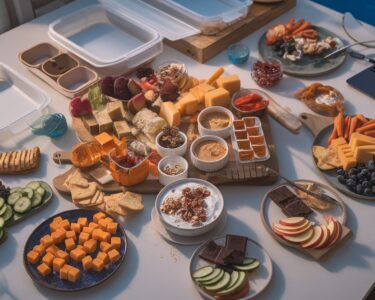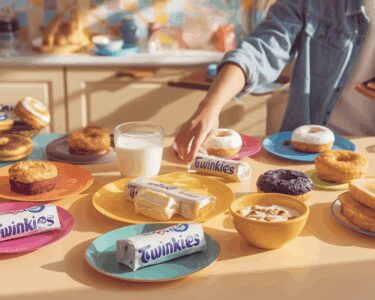Why Gen Z Is Eating Like Toddlers? marks a major shift in food culture, with 73% actively looking for comfort foods that remind them of childhood. This trend has turned simple, compartmentalized meals into a cultural statement across social media, especially on TikTok where the #GirlDinner hashtag has collected billions of views showing snack-focused plate arrangements.
Key Takeaways
- Economic pressures and rising food costs have pushed Gen Z toward budget-friendly, pre-packaged snacks with longer shelf lives and minimal preparation requirements.
- Gen Z faces unprecedented stress levels, according to the APA’s ‘Stress in America’ report, making simple “low-cognitive load” meals appealing as comfort and stress management tools.
- While nostalgic foods like Kraft Mac & Cheese contain high sodium levels, Gen Z embraces an ‘all foods fit’ philosophy that balances comfort with health consciousness.
- Social media has normalized and validated simplified eating patterns, removing stigma from processed foods and transforming basic combinations into trendy content.
- Major food companies, including Kraft Heinz, General Mills, and PepsiCo, have capitalized on this trend, experiencing significant sales growth in childhood staples like Lunchables and Uncrustables.
The Rise of Toddler-Style Eating Among Gen Z: A Comfort Food Revolution
Why Gen Z is Eating Like Toddlers: The Nostalgia Factor
There’s a remarkable shift happening in eating habits, and I’ve noticed Gen Z leading the charge back to childhood favorites. Recent data shows 73% of Gen Z consumers actively seek out foods that spark memories of their past. This isn’t just a passing trend – I’ve seen how deeply this generation connects with nostalgic eating through toddler-style food combinations that remind them of simpler times.
The numbers tell a compelling story. Brands that dominated our childhood lunchboxes are experiencing a major comeback. Lunchables, for instance, has reported double-digit growth as Gen Z embraces these familiar compartmentalized meals. I’ve watched as other childhood staples like Uncrustables, Goldfish crackers, and Kraft Mac & Cheese fly off shelves at unprecedented rates.
Social Media’s Impact on Why Gen Z is Eating Like Toddlers
The viral #GirlDinner trend has transformed how this generation approaches mealtime, amassing billions of views on TikTok. These snack-focused plate arrangements often feature:
- Chicken nuggets with various dipping sauces
- Pizza rolls paired with childhood favorites
- Compartmentalized plates filled with Goldfish crackers
- Mix-and-match combinations of pre-packaged snacks
This shift marks a notable departure from Millennial food culture. While Millennials chased elaborate food experiences, Gen Z gravitates toward comfort snacking routines and familiar flavors. I’ve noticed they’re creating their own modern versions of bento boxes, filled with childhood classics rather than sophisticated ingredients.
What’s particularly interesting is how this generation has turned these simple food choices into a cultural statement. They’re not just eating like toddlers – they’re proudly sharing their nostalgic meals online, creating a community around comfort food, and rejecting the pressure to present elaborate, adult-looking plates.
Economic and Mental Health: The Perfect Storm for Simple Food Choices
Why Gen Z is Eating Like Toddlers: A Mental Health Perspective
The growing trend of Gen Z gravitating towards simple, comfort-focused meals isn’t just about nostalgia – it’s deeply rooted in mental health challenges. According to the APA’s ‘Stress in America’ report, Gen Z faces unprecedented stress levels compared to other generations. This emotional burden has created a direct impact on their eating habits, pushing them towards simple comfort foods that remind them of childhood.
I’ve noticed that when stress levels peak, many Gen Zers turn to what I call “low-cognitive load” meals – foods that don’t require complex decision-making or preparation. This explains why Gen Z is eating like toddlers, opting for straightforward combinations that offer emotional comfort without mental strain.
Economic Pressures Driving Food Choices
The Bureau of Labor Statistics has documented significant increases in food-at-home costs, forcing Gen Z to make practical compromises. These financial constraints have created a perfect storm, pushing young adults toward budget-friendly snack plates and processed options.
Here’s how economic factors are shaping Gen Z’s eating habits:
- Pre-packaged snacks cost less than fresh ingredients
- Simple meals require fewer ingredients, reducing overall grocery expenses
- Processed foods have longer shelf lives, minimizing waste
- Basic food combinations need minimal cooking equipment
- Quick snack-based meals reduce utility costs
Social media has played a crucial role in normalizing these simplified eating patterns. Platforms like TikTok and Instagram showcase creative ways to arrange simple foods, turning basic combinations into trendy content. This digital validation has helped remove the stigma from eating simple, processed foods, making it more acceptable for Gen Z to embrace these childhood-inspired eating patterns.
The intersection of mental health challenges and economic pressures has created an environment where simple, familiar foods aren’t just a choice – they’re a coping mechanism. By understanding these underlying factors, I can better appreciate why Gen Z is eating like toddlers and how this trend reflects broader societal challenges.
The Health Debate: Why Gen Z is Eating Like Toddlers
Nutritional Concerns vs Comfort Food Benefits
I’ve noticed a fascinating trend in why Gen Z is eating like toddlers, which balances comfort with health consciousness. While traditional comfort foods might raise nutritional red flags – with Kraft Mac & Cheese packing 700mg of sodium per serving – there’s more to consider than just numbers. These nostalgic food choices, like creative bento box meals, actually serve a deeper purpose in managing daily stress.
The rising popularity of toddler-style plates and portions shows how Gen Z approaches eating differently. Their ‘all foods fit’ philosophy champions balance over restriction, making room for both wellness and comfort. This generation isn’t just mindlessly snacking – they’re creating aesthetically pleasing snack plates that satisfy both nutritional and emotional needs.
The Market Response to Why Gen Z is Eating Like Toddlers
Food companies aren’t missing this shift in eating habits. They’re quick to tap into Gen Z’s love for nostalgic snacking routines, resulting in impressive sales growth for major brands like:
- Kraft Heinz
- General Mills
- Kellanova
- PepsiCo
- Smucker’s
While ultra-processed foods carry potential health risks, Gen Z’s approach isn’t about going all-in on junk food. Instead, they’re creating a new food culture that values emotional wellbeing alongside physical health. This generation understands that sometimes, the comfort of familiar foods matters just as much as their nutritional content.
The dual interest in wellness trends and nostalgic foods might seem contradictory, but it reflects a more nuanced understanding of health. By portioning these comfort foods on divided plates and mixing them with fresher options, Gen Z is crafting a sustainable approach to eating that nourishes both body and mind.
With a craving for nostalgic comfort foods, many young adults are gravitating toward snacks and meals that remind them of childhood, as explored in how Gen Z is changing what we eat.
Sources:
American Psychological Association – “Stress in America”
Bureau of Labor Statistics – Consumer Price Index Report
Food Dive – “Kraft Heinz eyes Lunchables growth beyond just kids”
The Wall Street Journal – “Gen Z Comfort Food Eating Habits”








